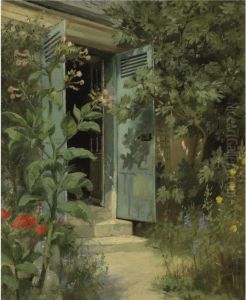Marie Adrien Lavieille Paintings
Marie Adrien Lavieille was a French artist born on October 29, 1852, in Paris. She was the daughter of the landscape painter Eugène Lavieille and the granddaughter of the military topographer Adrien Dauzats. Raised in an artistic environment, Marie Adrien showed an early inclination towards painting, which was nurtured by her father's guidance.
Marie Adrien Lavieille's career as a painter began in earnest in the late 19th century, a time when the art world was experiencing significant changes with the rise of Impressionism. However, her work remained more traditional, reflecting the training and influence of her father. She is known for her landscapes, interior scenes, and still lifes, which were executed with precision and a delicate touch. Her paintings often depicted the French countryside, including the areas around Paris, Brittany, and the Normandy coast, which were popular with artists of the time.
Lavieille exhibited her work at the prestigious Paris Salon, the annual exhibition of the French Academy of Fine Arts, which was the official art exhibition of the Académie des Beaux-Arts in Paris. Her participation in the Salon helped to establish her reputation as a skilled painter. Despite the male-dominated art scene of the period, Marie Adrien managed to garner respect and recognition for her artistic talents.
Marie Adrien Lavieille was not only a painter but also a printmaker, and she explored the art of etching, which was quite popular among French artists of the period. Although not as well-known as some of her contemporaries, her work contributed to the rich tapestry of French art in the late 19th and early 20th centuries.
She continued to paint throughout her life, and her artistic production was consistent and prolific. Marie Adrien Lavieille passed away on September 28, 1911, in Paris. Today, her works can be found in private collections and occasionally appear in art auctions, though she is less celebrated than some of her Impressionist contemporaries. Her contributions to the arts remain a testament to the talent and perseverance of women artists during a period when they were often overshadowed by their male counterparts.
